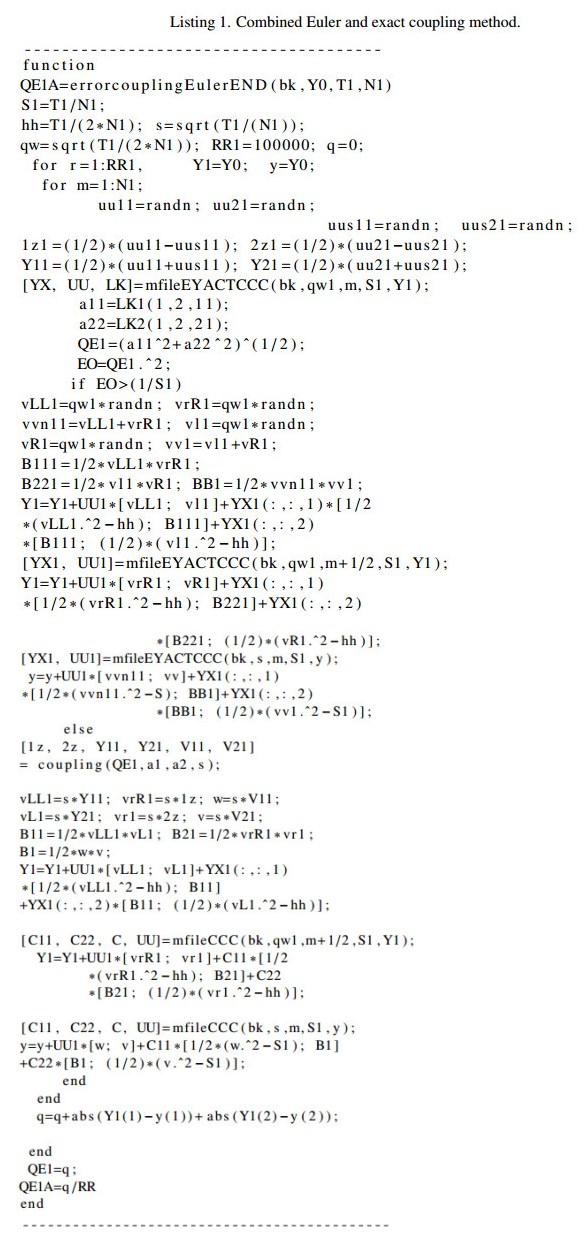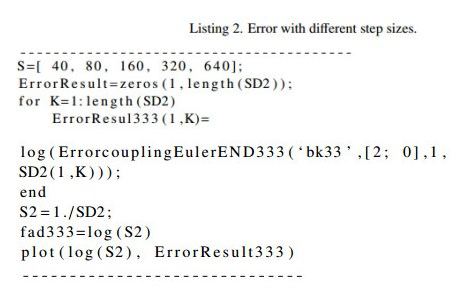1.
Introduction
The stochastic differential equation (SDE) computational solution plays an essential role in a broad spectrum of applications. The approximate solution of SDEs has received great attention because of their implementation in many science fields. This paper aims at a modern approach involving the simulation of an SDE solution. A method that combines trivial coupling with exact coupling is discussed in [1]. However, we use the Euler scheme to tackle trivial coupling in the present study. In [3], the The important approach mentioned used a random Taylor expansion to evaluate the optimal order of the estimated solution. In [3,4,6], a method is developed to approximate double integrals in all dimensions using the Fourier expansion in the Wiener approach. This method, however, required a significant amount of computation time.There are many applications for finding numerical solutions to stochastic differential equations using several innovative methods, see [13,14,15,16,17,18,19]. Also Rio in [7] continues his research for the Vaserstein bound to give precise bound estimates. In [5], Alhojilan used the Brownian multidimensional motion and established a good stochastic difference equation solution. Convergence of an approximation to a strong solution on a given probability space was established by Gyöngy and Krylov in [11] using coupling. Due to its superior properties for many problems, solutions to fractional stochastic differential equations (FSDEs) driven by Brownain motion have recently received much attention from scientific researchers, see [8,9,10]. We also checked some prior studies on SDE numbering using a coupling method. We reflect primarily on the study of Davie [2], which used an exact combination and an estimated coupling method to achieve order 1, under some conditions for a good convergence. Because the stochastic difference equation is not an invertible matrix, we established the result of the convergence of the exact coupling method combination using the Euler process. We've frequently used a condition to govern how the entity matrix behaves while it's at zero. The convergence cannot be in order one due to the fluctuation between the exact method and the Euler technique. So, the combined approach O(S3/4sqrt|log(S)|) was established and given order better than Euler. As a result, this approach is seen to be superior to the Euler method. This document is structured accordingly. Section 2 summarizes recent SDE studies and addresses Davie's methodology [2]. Section three discusses the integrated correct relation and system of Euler. Section 4 offers a numerical example of convergence behavior.
2.
Stochastic differential equations (SDEs)
Consider the following SDE
where i = 1, ..., n on [0,T], Y(t) is a n-dimensional vector, and V(t) is a n-dimensional path. Further the coefficients Bik(t,Y(t)) satisfy a global Lipschitz condition
and
for all t∈[t0,T] and Y,y∈R, with A>0 is a constant.
Now assuming Ai and Bi are continuously on t for each Y. Then there is a unique solution Y(t) to the Eq (2.1). To find an approximate solution on this interval [0,T], we divided this interval into positive into N intervals which are equal length, i.e. S=T/N. Adding the following quadratic terms to the Euler scheme yields the Milstein scheme: ∑dk,l=1χikl(jS,Y(j))P(j)kl. Thus we get the following scheme
where
and
If the commutativity condition
holds for all Y∈Rd, t∈[0,T] and all i,k,l, Milstein's scheme is reduced to
Note that the prior approach is just reliant on Brownian motion implementation ΔV(j)k. We may use ΔV(j)k only and apply the special equations for Milstein method. This can be implemented from: The observation that P(j)kl+P(j)lk=2F(j)kl where F(j)kl=12ΔV(j)kΔV(j)l for k≠l and F(j)kk=12{(ΔV(j)k)2−S}. Moreover, we note that if d=1 or d>1, the scheme (2.9) is of the first order or of order 12, respectively. As delineated in Davie's paper [2], we tend to modify scheme (2.9), which can provide the order 1 with the invertible diffusion. The interpretation of producing the distribution will be modified in scheme (2.9), according to the Davie article to produce a convergence of order one under a certain condition.
Therefore, if we need to implement the Milstein method, we begin by implementing the random variables as follows: ΔV(j)k and P(j)kl on an individual basis. Later, we add these random variables to obtain the right-hand side of scheme (2.9). Here, we are seeking to directly generate the subsequent
If we have a scheme
where the increment Y(j)k are independent of N(0,S) random variables, then it is similar to scheme (2.9) with ΔV(j)k replaced by Y(j)k without assuming ΔV(j)k=Y(j)k.
3.
Euler with exact coupling in two-dimensional SDE
3.1. Exact coupling scheme
First, we'll look at scheme (2.11) in its explicit form. For the sake of simplicity, we'll let Bik(y) rely solely on y and leave the drift term at zero. So
In [12], after showing the order of exact coupling method we obtained the following scheme
where τikl=12∑jcijχikl, and the size of the step is S(r)=T2r. So as we established in [1], the order of local error of the exact coupling method is E|y(r,1)−y(r+1,2)|2≤D2a2S3, where a and D2 are functions of y(r,j).
3.2. Local error of Euler scheme
In [3], the local error of the Euler method is E|y(r,1)−y(r+1,2)|2≤D1S2, where D1 is a constant.
3.3. Local error of Euler with exact coupling in two-dimensional SDE
A similar proof of the combined method exact coupling and Euler method is used in [1]. As a result, using the combined approach, we get the following order of local error:
So, we have a similar approach to the theoretical concept; however, our method uses a completely different scheme. That is the Euler scheme rather than trivial coupling. Therefore, the MATLAB code and the results of the implementation is different.
3.4. Explanation of the combined method
We want to determine the value of a as a function of y(r,j) at the jth step. In addition, we'd want to determine D1 and D2 in (3.4) as functions of y(r,j). Thus in each loop and within the same stage, we can choose between two approximate solutions. The first is an estimated solution with the exact coupling utilizing scheme (2.11). This gives the local error E|y(r,1)−y(r+1,2)|2≤D2a2S3. The alternative approximate solution utilizes the Euler method, which obtain the local error E|y(r,1)−y(r+1,2)|2≤D1S2 where D1, may be a constant independent of S. Therefore, from the value of the function a and using the next condition, for D2a2S3>D1S2 follows to select the answer that has the Euler scheme. If not, we use the other answer, which follows scheme (2.11) with exact coupling.
It is found that we cannot explicitly use exact coupling with a single matrix (2.11) in the MATLAB execution since the (Bik(Y)) matrix determinant is 0 or similar to 0. This will change the convergence order. We therefore regulate this issue with the above-mentioned situation.
We currently demonstrate how the local error for the merged procedure is complied with and what local error can be achieved. We need to clarify this principle and then numerically evaluate it for a specific stochastic differential equation with application examples.
Consider
Thus, the following convergence of the local error is obtained for the combined method
and we obtain the global error for the combined method, which is as follows:
Finally, we show that for the combined approach, the order of convergence is h3/4√|log(S)|, for a variety of implementation for a selected SDE, which is singular.
4.
Matlab implementation
Consider the following two-dimensional not-invertible SDE:
where V1(t) and V2(t) are two separate standard Brownian motions. To solve this SDE using a numerical technique. Simulate the solutions for the same Brownian path using two distinct step sizes (S and S/2) at the same time. The MATLAB code in the listing presented below views at the strong convergence of the combined Euler and exact coupling method in two-dimensional SDE. We compute (for example, R=2000) different Brownian paths over the interval [0,2] at a range of step-sizes.
As mentioned earlier, the strong order for the combined method is S3/4√|log(S)|. The above MATALB code runs with totally different step sizes over an oversized number of paths, R, as follows:
The command (ErrorResult333(1, i) = log(ErrorcouplingEulerEND333('bk33', [2; 0], 1, S2(1, K))); ) calculates the ϵ=1R∑RK=1|Y(K)S−Y(K)S/2| with different step sizes. The following table outlines the experimental error with respect to the five different time steps.
We can see from the results presented in Table 1 and the plot in Figure 1 that the combined Euler and coupling method converges strongly with order S3/4√|log(S)|.
5.
Conclusions
We established the result of the convergence of the exact combination with the Euler procedure because the stochastic difference equation is not invertibly diffused. We have often used a certain condition that controls the behavior of the entity matrix at zero. Obviously, because of the fluctuation between the exact joining phase and the Euler method the convergence cannot be in order one. The combined method O(S3/4√|log(S)|) was then obtained. This technique is thus considered to be better order than the Euler method.
Conflict of interest
Authors declare no conflicts of interest.











 DownLoad:
DownLoad:




